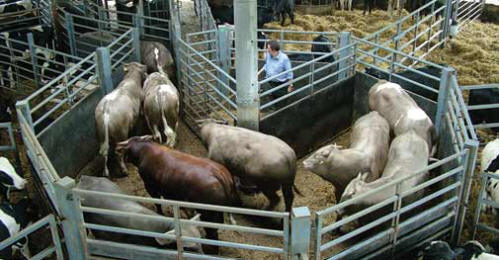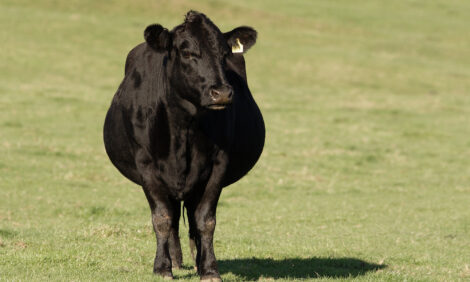



Roundhousing For Beef
A relatively new concept for housing animals is the Roundhouse. An adaptable building, deisgned for improved animal welfare, increased handler safety, easy loading and cost effective livestock management. Charlotte Johnston, TheCattleSite junior editor, went to Cannon Hall Farm, near Barnsley to see how it works in practice.
To look at, the building is definitely different from the average conventional livestock shed. It is, as the name suggests, round. In fact, the building has a diameter of 30m and a circumference of 95m, which results in an area of 718m2, providing housing for up to 150 animals. For further welfare purposes, Mr Nicholson, the farm manager at Cannon Hall Farm, doesn't stock above 120 cattle.
The building is open sided, with a 10m2 roof vent, designed to allow good ventilation and air flow. Mr Nicholson, believes that the excellent ventilation improves animal health, recording no cases of pneumonia since the building was erected in February, earlier this year.
Finishing around 300 head of cattle a year, Mr Nicholson says that the new Roundhouse has definitely improved labour efficiency. Labour efficiency is of importance to Mr Nicholson, who on top of his beef enterprise opens the farm to the public. Animals found at Cannon Hall range from commercial cattle, sheep and pigs to rare breeds and alpacas, llamas and wallabies as well as a variety of birds.
With a requirement for a new building, Mr Nicholson started to look around. "I wanted to see something new in the local area and liked the look of the Roundhouse," he said. Aesthetically pleasing to look at, he said that it was straight forward to get planning permission. It has certainly been beneficial for Cannon Hall Farm, the new Roundhouse has been fitted with a viewing platform, which takes visitors from the exterior of the building to an all round platform fixed to the centre column, allowing visitors to see animals without bothering them.

Among its many benefits, it can argued that the most useful asset of the Roundhouse is the excellent handling facilities in the centre of the building. Cattle can be handled efficiently with minimum stress for both the handler and stock. Escape gaps in each pen division increase handler safety. The handling system allows labour to be saved as it is possible for one person to handle the stock alone. Mr Nicholson says that he would recommend the Roundhouse to others on grounds of the handling facilities alone.
The collecting/ crowd pen is accessible from all pens to deliver stock to the race and crush. Cattle can run through the crush into a holding pen, from which they can be quickly and stress free loaded onto a trailer, or run back into the pens.

The flexibility of the roundhouse allows pen size and the number of pens to vary. At Cannon Hall there are six standard pens of around 90m2 each and one larger pen of 180m2. When asked whether growth rates have improved and if it has been noticed whether cattle are finished faster, Mr Nicholson said that it is likely some cattle are finished faster, but as the building has only been up eight months it was difficult to tell. "As with all farming systems, some cattle will reach the required weight sooner than others," he says.
Cattle are bought in at about 12 months of age and fattened to between 550-750kg, when they are sold at 18-22 months of age. Aiming to grow one kilogram a day, they are fed a spring whole crop silage consisting of chopped barley and peas. For every one tonne of forage fed, cattle also receive half tonne of concentrate.
A feed trough around the circumference of the building, provides easy access for stockmen. At Cannon Hall Farm, a Keenan Feeder Wagon is used for simplicity. Mr Nicholson believes that less straw is required than in a conventional building and is hoping to get a straw blower to make bedding out more efficient.

A system to harvest rainwater is optional, but was not adopted at Cannon Hall Farm. The rainwater can be diverted into channels running down the outer support columns of the buildings, and then into the drainage system to prevent the water ending up on yards. This harvested water could be diverted to supply the building. Water troughs are rounded to prevent bruising to animals.
The cost of the building includes all planning applications and consultations, site preparation, levelling and hardcore, the cost of erection, drainage, internal divisions, feeding and handling, electrics and water connections. Mr Nicholson says that the cost of his building was substantially more than it would usually be, this is due to a large surrounding concrete area required for visitors and the viewing platform.
The basic cost of a Roundhouse would be £95,000, with the building cost alone being around £53,000. This would work out around £132/m2. Dairy Co's Housing the 21st Century Cow predicts the cost of a general pupose building at £148/m2 or a straw bedded yard building at £146/m2, which are unlikely to include the site preperation or internal divisions etc.
Mr Nicholson is currently in talks with the Roundhouse regarding designing a bigger building, with a diameter of 50m which could house 300 head of cattle.


